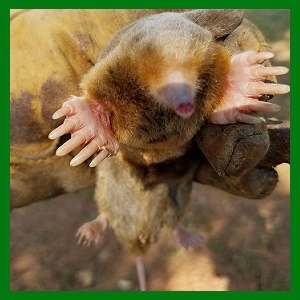Damage to lawn and landscaping is usually done by moles, gophers, skunks, and armadillos. All are looking for the same food, earthworms, grubs, and other insects. The gopher is an exception as it’s a vegetarian and feeds on roots and plants.
OFWC can remove the offenders and attempt to repair the damage. For extensive damage, a landscaping company will be needed.

Skunk Trapping
Skunk living under the house, an out-building, or in the yard? That awful smell gives them away every time. Besides the smell, skunks may also dig in the lawn and landscaping searching for food.
Old Fort Wildlife Control can safely trap the skunks and remove them from the property.
Identification
A striped skunk is a house-cat-sized mammal with black fur and an unmistakable white strip or V from head to tail. The skunk uses an extremely noxious odor as a defense mechanism. Skunks are nocturnal rarely seen during the daytime. Skunks are burrowing animals so drawn to crawl spaces and under outbuildings. It is common for several skunks to den together which contributes to the higher rate of rabies than other animals.
Skunk mating season starts mid-late February so males are roaming around looking for females. If a female is living on or close to your property, she will attract all the males in the vicinity.
Removal Method
OFWC uses cage traps to safely catch and remove skunks without additional odor. Once they are all removed, repairs can be done to make sure another skunk doesn’t move in.

Mole Trapping
Are moles tearing up your yard and landscaping with tunnels and dirt mounds?
Mole trapping and removal is available from April-November. A typical yard may have 2-6 moles.
Identification
A mole is a mouse-sized mammal that lives underground. It has grey or brown fur, a short tail, large front paws for digging and small back legs for moving. It lives on a carnivore diet eating mostly earthworms then grubs and other insects. It has eyes but are mostly useless since it lives in darkness. Moles have a very good sense of smell for locating their food, When a good food source is found, like a yard with lots of worms, a tunnel complex is built for sleeping, eating, and traveling.
While searching for food, moles make golf ball size tunnels slightly underground leaving an unsightly trail of raised earth. Moles can also make dirt piles on the surface, from baseball to basketball-sized, which are the excavations of a tunnel system that cannot be seen from the surface.
In winter, moles follow their food source deep underground and cannot be caught except on a streak of warm days.
Removal Method
Small, lethal traps are used inside the most active tunnels, safe from kids, pets, and mowing equipment. Traps are checked every few days and moved as needed. As moles are caught, mounds are cleaned up and tunnels are smashed. Severe damage may require heavy equipment like a riding mower to smash the tunnels. When damage stops, traps are removed.

Armadillo Trapping
Armadillos are an invasive species that can cause damage to lawns and landscaping when they are digging for insects to eat, and when they dig dens against foundations, in the yard, and in flower beds. These dens make excellent homes for other nuisance species if the armadillo abandons the den.
Identification
The armadillo is a barrel-shaped mostly nocturnal animal with a leathery armored shell, a thin pointy head, and long claws for digging. Usually 24 -30 inches nose to tail and weighs 8-12 lbs. The armadillo is nocturnal although can sometimes be seen during daylight. Its food source is earthworms, grubs, and yard insects, the same food source as moles and skunks.
An armadillo will dig golf-ball-size or smaller holes in the lawn looking for food. It may also dig a large burrow against the house foundation, behind air conditioning units, under landscaping bushes, or anywhere the dirt is soft and free of rocks.
Removal Method
Cage traps are used to catch armadillos. There is no effective bait for armadillos so traps are placed in travel ways or at burrows. After the armadillo is removed we will locate the den (if on the property) and fill it in to discourage other animals from moving in.
